Audi has given its acclaimed R8 a bit of a mid-cycle spruce up and we reckon they’ve done a grand job. The headline act is a new V10 plus Coupé (pictured above). Hairdressers need not apply, as it’s available in hardtop Coupé form only. The R8 V10 plus takes the 386kW/530Nm from the regular V10 model and ups the ante to 404kW and 540Nm.
As you can see there’s new lighting treatments for the R8, as well. Now standard across the board are LED headlights for both low and high beam. These days standard old indicators don’t cut the mustard, so Audi has fitted the rear light assembly with “dynamic indicators”; these illuminate outwards in the direction the driver is about to turn.
For the first time the R8 gets a proper S tronic double clutch transmission, ridding itself of the cumbersome R tronic gearbox. The 7-speed S tronic is standard on V10 models and optional on V8s. The new ‘box is less than 600mm in length and places its two multi-plate clutches behind one another.
The interior hasn’t been left untouched, either, with minor cosmetic tweaks designed to keep the R8 looking fresh. We quite like the optional quilted alcantara headlining, which looks great with its matching seats.
Australian buyers keen to get their hands on the facelifted R8 will have to wait until early 2013. They’ll also need a good relationship with their local Audi Centre if they want pricing ahead of the official announcement at next year’s launch.
We’ve compiled a quick reference performance table for you below before you sink your teeth into Audi’s pics and press release after the break.
| Model | Capacity | Power/Torque | Coupé 0–100km/h | Spyder 0–100km/h |
|---|---|---|---|---|
| S tronic / manual | S tronic / manual | |||
| R8 V10 plus | 5203cc | 404kW/540Nm | 3.5s / 3.8s | na |
| R8 V10 | 5203cc | 386kW/530Nm | 3.6s / 3.9s | 3.8s / 4.1s |
| R8 V8 | 4163cc | 316kW/430Nm | 4.3s / 4.6s | 4.5s / 4.8s |
Audi R8 V10 plus Coupé
Audi R8 V10 Coupé
Audi R8 Spyder
Audi R8 V8 Coupé
The Ultimate Supercar Reborn: The New Audi R8
- Presenting the R8 family from Audi, overhauled in numerous details
- The new top model R8 V10 plus, with a new 7-speed S tronic for all variants
- LED headlights and indicator lights with dynamic display are standard
Audi has made its R8 high-performance sports car even more attractive and dynamic. The R8 V10 plus is a new top model in the model series, with a totally new 7-speed S tronic. The LED headlights and the new rear indicator lights with dynamic display are standard equipment on all variants.
4.44 metres long, 1.90 metres wide and only 1.25 metres high (Spyder: 1.24 metres) – the broad Audi R8, developed and built by quattro GmbH, stands firmly on the road, ready to pounce. New details lend an even sharper design. The single-frame grille with the beveled upper corners is painted high-gloss black, with horizontal chrome inserts adorning the struts on the V10 variants. The bumper is also new, with the air inlets bearing three crossbars each. As an option, Audi installs a front splitter made of carbon fibre reinforced plastic (CFRP). The splitter is standard on the new R8 V10 plus.
LED headlights with a new technology are now standard on all variants of the Audi R8. The light-emitting diodes for the high and low beams have been placed above and below the strip-shaped daytime running lights, which are specially actuated to serve as indicators. In addition, static turning lights are integrated in the headlights.
The housings of the outside mirrors and the side blades, the lateral air inlets on the Coupé, are made from CFRP on the new R8 V10 plus top model. In the 10-cylinder variants the blades extend outwards farther than on the V8 and have special edging; small marks of distinction also occur at the sills. The vent louvres next to the rear window have an aluminium look on the R8 V10 Coupé (matt black on the R8 V8 Coupé and R8 V10 plus). As an option, LEDs illuminate the engine compartment; in the R8 V10 plus this illumination as well as a partial CFRP lining for the engine compartment are standard.
The LED lights dominate the rear of the Audi R8. One innovation from Audi is the indicator light with dynamic display at the bottom edge of the lamp – its light always proceeds toward the outside, in the direction the driver wishes to turn. Above the high-gloss black area between the vent openings sits the new badge – the letter ‘R’ resting partly on a red diamond, the Audi Sport signature. The large diffuser, optionally CFRP (standard on the R8 V10 plus), has been pulled far upwards. In all engine versions the exhaust system terminates in two round, glossy tailpipe trim sections, painted black on the R8 V10 plus.
Audi offers the R8 in the two solid colors Ibis White and Brilliant Red, in four metallic shades and with five pearl effect / crystal effect coatings. For the R8 V10 plus a matte effect color is available as an exclusive feature. The side blades on the Coupé come in eight colors, while the soft top of the R8 Spyder comes in black, red or brown.
The R8 embodies Audi’s full expertise in ultra-lightweight design. The aluminum body with the Audi Space Frame (ASF) weighs only 210 kilograms on the Coupé, and 216 kilograms on the Spyder. The unladen R8 V8 Coupé with manual transmission registers just 1,560 kilograms on the scales, while the open-top sports car weighs 1,660 kilograms. The R8 V10 plus, available only as a coupé, brings the needle to 1,570 kiloÂgrams. Adjustable bucket seats with fibreglass reinforced plastic chassis, less use of insulating materials, special light alloy wheels and chassis components, including the standard ceramic brakes, as well the CFRP add-on parts at the body all contribute to lowering the weight.
On the Audi R8 Spyder the lid on the soft top compartment and the side parts are also CFRP. The elegant, lightweight fabric top, with its largely aluminium and magnesium linkage, is the crowning touch to the ultra-lightweight design. The top opens and closes electrohydraulically in 19 seconds, and during driving at up to 50 km/h. The heated window pane in the bulkhead between the passenger and engine compartments stands apart from the soft top; the window can be retracted and extended by a switch and also serves as a wind deflector. In case of a pending rollover, two strong, spring-tensioned sections shoot upwards from the seats.
As in car racing, the aerodynamics of the Audi R8 have been optimised for propulsion. The underfloor contains five NACA nozzles, along with two diffusers in the front section, which increase the propulsion at the front axle. The drag coefficient is 0.35 or 0.36 depending on the engine version and body shape; the frontal area measures 1.99 m2.
The engines are assembled by hand. The V8 with 4,163 cc displacement and the V10 with its 5,204 cc displacement are captivating, naturally aspirated heavy-duty engines packed with power. The interplay with the new 7-speed S tronic has reduced CO2 emissions by up to 22 grams/km and decreased the sprint from zero to 100 km/h by three-tenths of a second. Both engines are compact and comparatively lightweight. The crankcase is an aluminum-silicon alloy; the bed plate structure provides high rigidity. The dry-sump lubrication allows low positioning of the engines; the pressure recirculation pump operates load-dependently, for increased efficiency.
The FSI direct fuel injection system allows a high compression of 12.5:1. Four adjustable camshafts control the valves. At low load and engine speed, flaps in the intake ducts bring about a precise, cylindrical rotation of the incoming air. The exhaust system is designed for low back pressure. The two tailpipes contain flaps; they open during sharp acceleration to produce a fuller sound.
The 4.2 FSI engine produces 316 kW at 7,900 rpm, with a torque of 430 Nm between 4,500 and 6,000 rpm. The unit accelerates the R8 Coupé with S tronic from rest to 100 km/h in 4.3 seconds and to a top speed of 300 km/h (with manual transmission: 4.6 seconds and 302 km/h). For the R8 V8 Spyder the corresponding values are 4.5 and 4.8 seconds, respectively, and also 300 km/h. On average the R8 V8 quattro as a coupé with S tronic consumes 12.4 litres of fuel per 100 km.
The V10 engine provides a torque of 530 Nm at 6,500 rpm, with 386 kW at 8,000 rpm. Its crankshaft is a common-pin design, yielding alternating ignition intervals of 54 and 90 degrees. This design combines maximum rigidity and low weight, while at the same time generating the unique car racing-like sound of the V10.
The Audi R8 V10 Coupé with S tronic accelerates from zero to 100 km/h in 3.6 seconds and reaches a top speed of 314 km/h. With manual transmission the values are 3.9 seconds and 316 km/h. The R8 V10 Spyder with S tronic completes the standard sprint in 3.8 seconds and has a top speed of 311 km/h (with manual transmission: 4.1 seconds and 313 km/h). The average consumption rate of the R8 V10 Coupé with S tronic lies at 13.1 litres of fuel per 100 km.
The new top model of the model series is the Audi R8 V10 plus. Developing 404 kW, its maximum torque is 540 Nm at 6,500 rpm. With S tronic, the R8 V10 plus, available only as a coupé, catapults from zero to 100 km/h in 3.5 seconds and achieves a top speed of 317 km/h; the average fuel consumption rate is 12.9 litres per 100 km. The key data with manual transmission are 3.8 seconds, 319 km/h and 14.9 litres.
Two power transmission systems are available for the overhauled Audi R8. The manual 6-speed transmission, with its lever leading into an open stainless steel gate, is standard on the V8 and optional on the V10. The new 7-speed S tronic – optional on the V8 and standard on the V10 – spaces the gears closely in a sporty mode; the final drive position has a wide gear ratio. The dual clutch transmission can be shifted at the selector lever or at the steering wheel paddles; a sports mode is alternatively available. At the press of a button the launch control manages starting at an increased initial engine speed and with optimal tire slip.
The new 7-speed S tronic, with a three-shaft layout, is less than 60 centimetres in length. Two multi-plate clutches lying behind one another (a new feature), serve two mutually independent sub-transmissions; gears are shifted directly as the clutches alternately open and close. Gearshifting occurs practically without interruption of tractive power within hundredths of a second, and so dynamically, smoothly and comfortably as to be hardly noticeable.
From the 7-speed S tronic the propeller shaft runs through the crankcase of the engine to the front axle, where a viscous coupling distributes the torque. In normal operation the coupling directs about 15 per cent of the torque to the front axle; when the rear wheels start to spin, a maximum additional 15 per cent flows to the front. A mechanical locking differential operates at the rear axle. The rear-load distribution of the forces ideally harmonizes with the mid-engined concept of the Audi R8. The axle-load distribution is 43:57 (front:rear), with small differences between the individual variants.
The chassis of the high-performance sports car employs technologies from car racing. Double wishbones forged from aluminum guide all four wheels. On the R8 V10 plus the springs and shock absorbers have been specially tuned and the camber values at the front axle adapted accordingly. The Audi magnetic ride adaptive damping is standard on the R8 V10 and optional for the V8 variants; it offers a normal mode and a sports mode. The power steering delivers finely differentiated, super-sensitive feedback, with sporty, direct gear ratios.
The overhauled R8 rolls along on large wheels. The V8 engine versions have the standard wheel dimensions of 8.5 J x 18 at the front and 10.5 J x 18 at the rear, with tyre sizes 235/40 and 285/35. On the V10 versions Audi mounts 19-inch wheels of widths 8.5 and 11 inches; the tyres come in the sizes 235/35 and 295/30 respectively. The optional wheels have especially attractive designs – polished to a high gloss, with a titanium look or (on the R8 V10 plus) in black gloss.
The steel brake discs of the high-performance sports car are internally ventilated, perforated and joined to the aluminum disc bowls by pins. The new “Wave” design of the discs – the wavy exterior contour – lowers the weight overall by about two kiloÂgrams compared with round disks of the same dimensions. The aluminium brake calipers operate at the front wheels with eight pistons each, and at the rear wheels with four pistons each. In combination with the 19-inch wheels, Audi can provide optional carbon fibre ceramic brake discs (standard on the R8 V10 plus). The electronic stabilisation control system ESC offers a sports mode and can also be fully deactivated.
The Audi R8 is a sports car with excellent practical skills. The front luggage compartment has a capacity of 100 litres; the Coupé accommodates an additional 90 litres behind the seats. The long wheelbase of 2.65 metres affords generous space. The interior conveys a car racing atmosphere on the luxury level; its dominant feature is the monoposto – the long arc curve running around the cockpit in the area of the driver. The flattened rim of the optional, more contoured R8 leather-covered multifunction sports steering wheel bears the new R8 badge, which also appears at the gearshift or selector lever, at the door sill trims, in the instrument cluster and on the start screen of the on-board monitor.
The electrically adjustable sports seats are optional on the V8 engine versions and standard on the V10 variants. Depending on the model variant, the seat upholstery is an Alcantara/leather combination or Fine Nappa; on the R8 Spyder a special pigmentation reduces heating from direct sunlight. Audi also offers optional bucket seats with prominent side sections for better lateral support (standard on the R8 V10 plus).
Numerous control and trim elements shine with subdued chrome strips or with black paint; the needles in the instrument cluster and the shift paddles have been slightly modified. The centre console and the handbrake lever are covered with leather, adorned by delicate seams; in the V10 models the moulding around the standard navigation system plus is also leather-covered.
With the diamond-stitched, Fine Nappa full-leather equipment level, the seats and the door trim feature quilted upholstery; for the R8 Coupé a quilted Alcantara headlining is also available. More individualistic customers can choose between leather items in different colors, inlays in Carbon Sigma (standard on the R8 V10 plus) and piano finish black. A wide range of design, styling and leather packages from the Audi exclusive customization line is also available.
The R8 V10 and the R8 V10 plus come with the navigation system plus and the Bang & Olufsen Sound System as standard on-board features. Other options for all R8 variants include a high-beam assistant, a stowage package, various travel case sets, a cell phone preparation, with belt microphone and voice control, and the parking system plus with reversing camera.
The updated Audi R8 will arrive in Australia in the first quarter of 2013. Price and specification will be announced closer to launch.
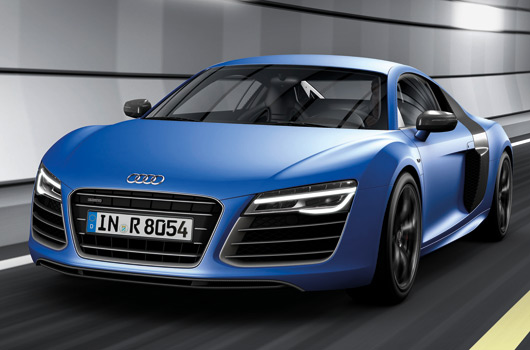
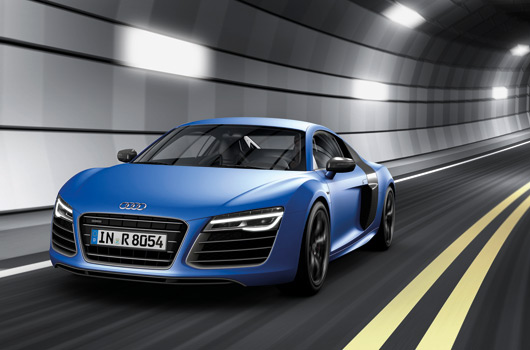
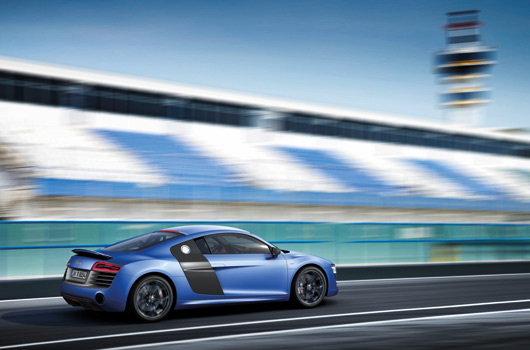
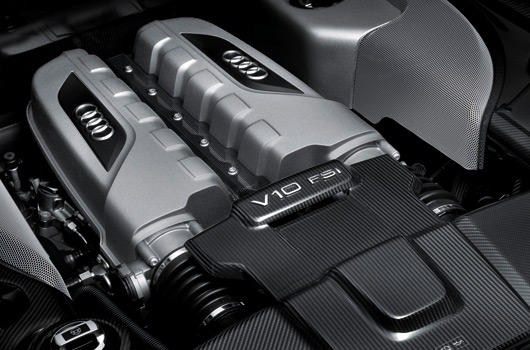
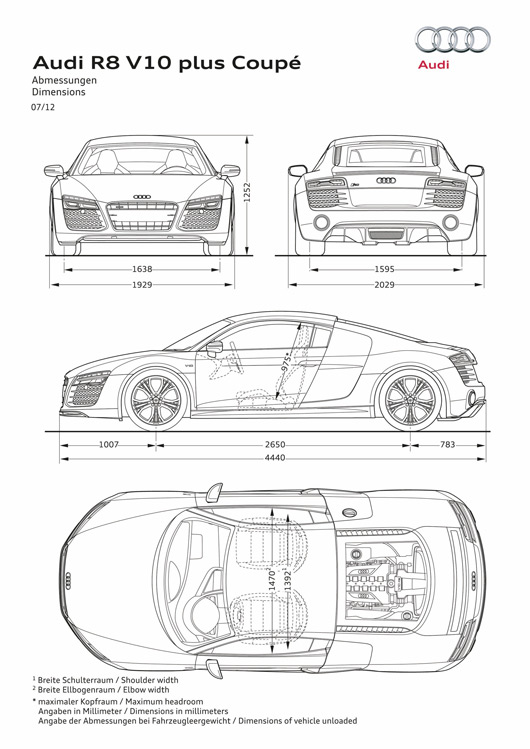
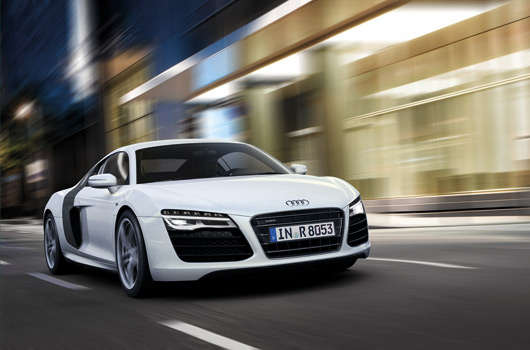
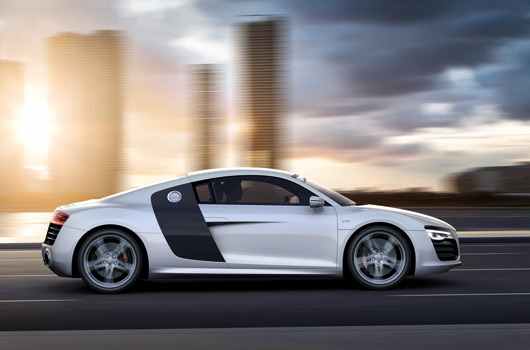
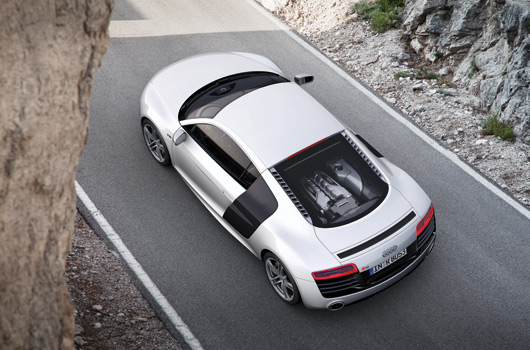
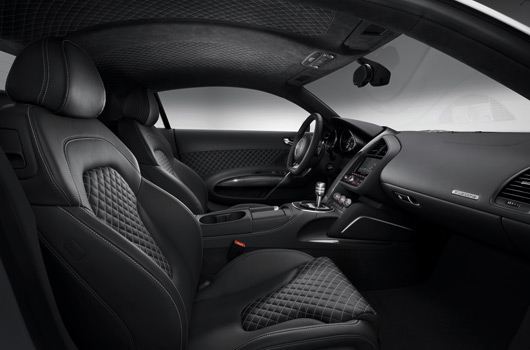
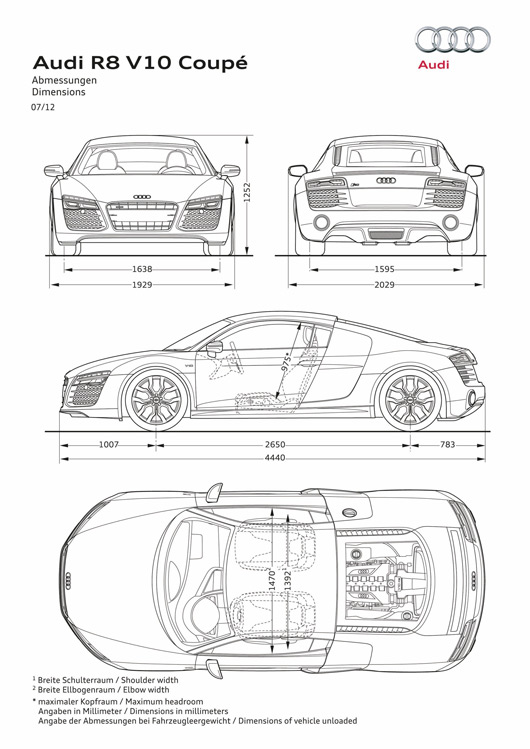
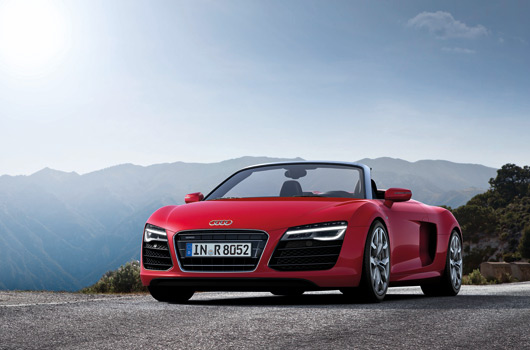
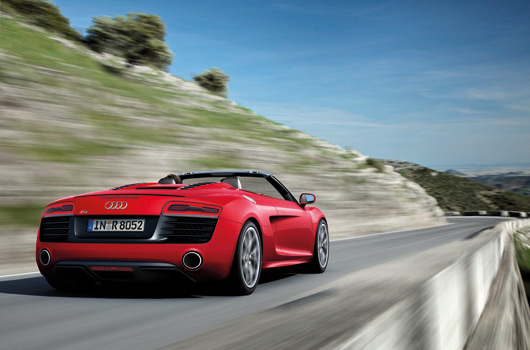
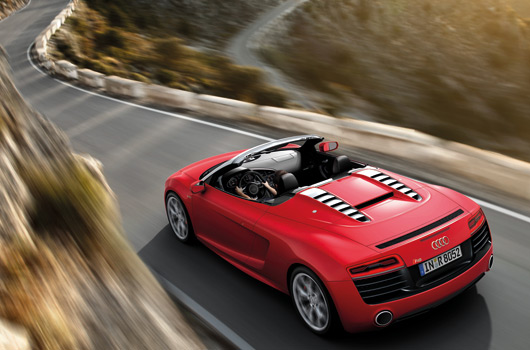
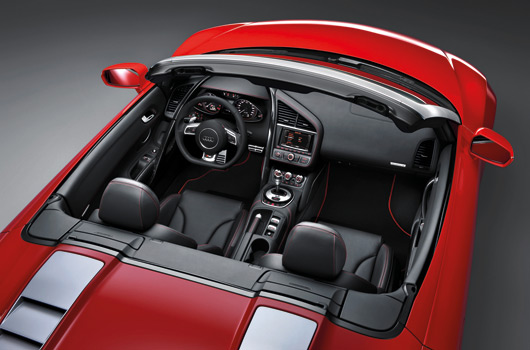
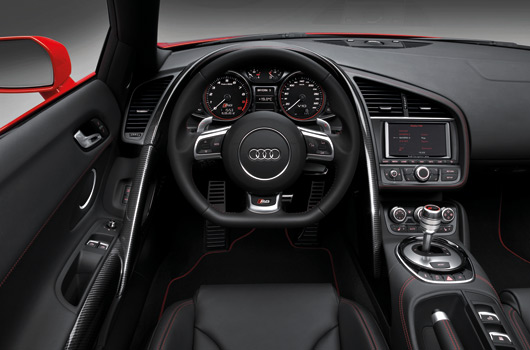
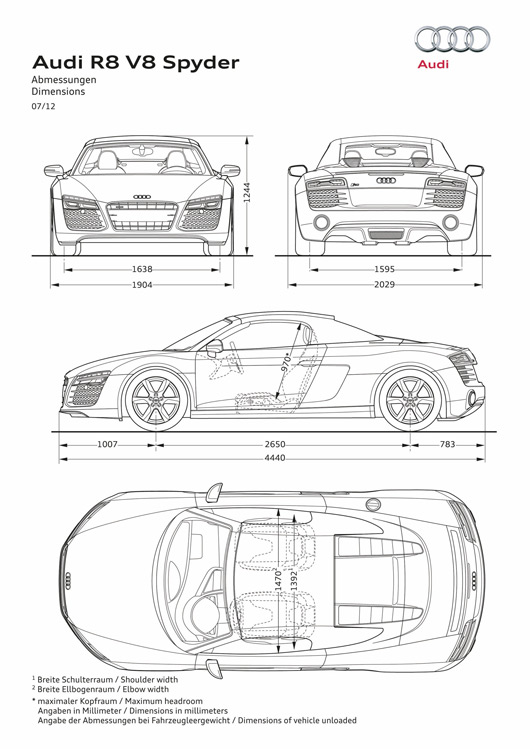
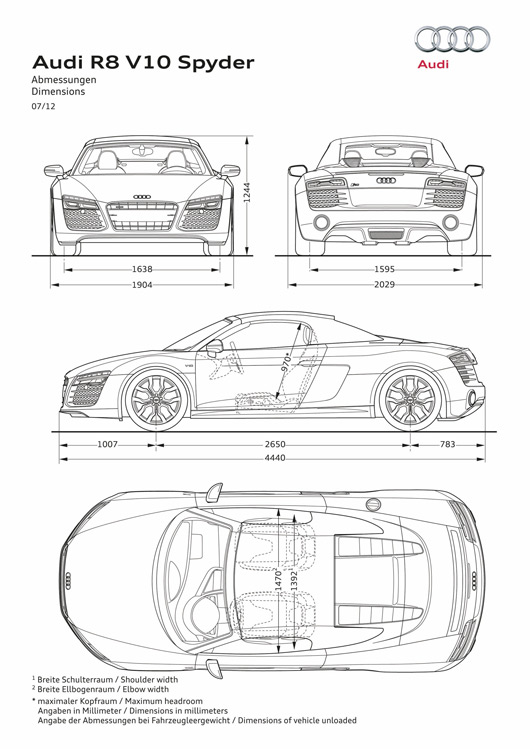
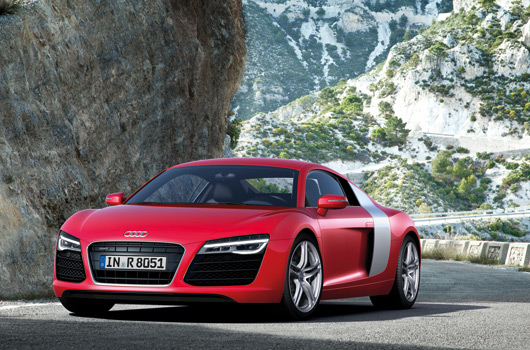
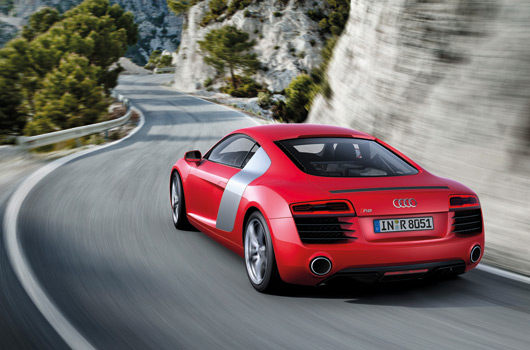
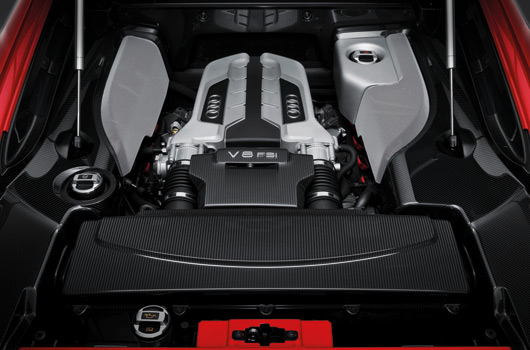
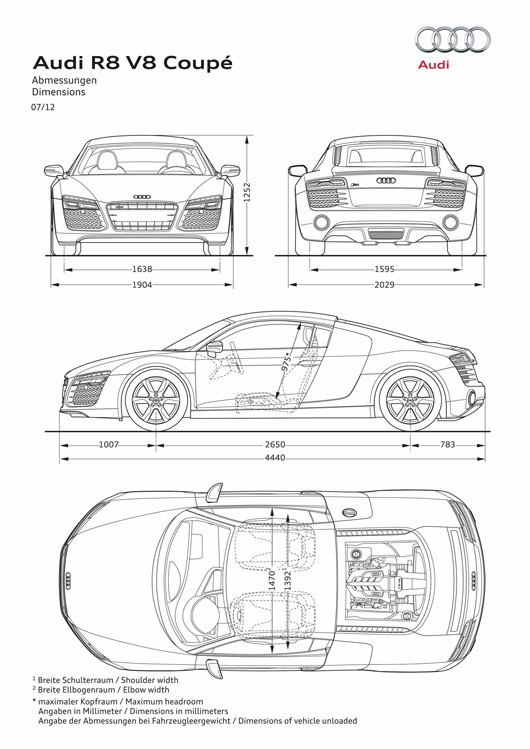
5 replies on “2013 Audi R8 facelift revealed”
http://www.ausmotive.com/2012/06/30/audi-r8-e-tron-sets-nurburgring-electric-record.html
Told ya….
Nicely spotted.
[…] UK brings us some photos of an arseless R8 V10 plus; that is, Audi, in their wonderful wisdom, has removed the cosmetic bits of the car’s back […]
[…] Australia has just launched the facelifted R8 to the local market. With that comes the 404kW R8 V10 plus, which boasts the title of Audi’s […]
[…] your latest Chris Harris fix. Today he’s at the wheel of the highly desirable Audi R8 V10 Plus, the equally wantable 997 Porsche 911 Turbo S and giant killing Nissan GT-R that’s been […]